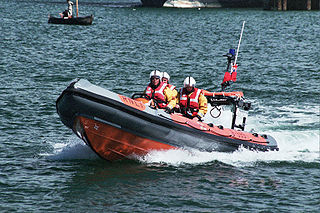
A rigid inflatable boat (RIB), also rigid-hull inflatable boat or rigid-hulled inflatable boat (RHIB), is a lightweight but high-performance and high-capacity boat constructed with a rigid hull bottom joined to side-forming air tubes that are inflated with air to a high pressure so as to give the sides resilient rigidity along the boat's topsides. The design is stable, light, fast and seaworthy. The inflated collar acts as a life jacket, ensuring that the vessel retains its buoyancy, even if the boat is taking on water. The RIB is an evolutionary development of the inflatable boat with a rubberized fabric bottom that is stiffened with flat boards within the collar to form the deck or floor of the boat.

A patrol boat is a relatively small naval vessel generally designed for coastal defence, border security, or law enforcement. There are many designs for patrol boats, and they generally range in size. They may be operated by a nation's navy, coast guard, police, or customs, and may be intended for marine, estuarine, or river environments.
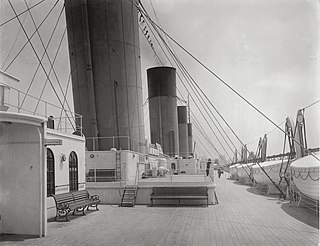
A deck is a permanent covering over a compartment or a hull of a ship. On a boat or ship, the primary or upper deck is the horizontal structure that forms the "roof" of the hull, strengthening it and serving as the primary working surface. Vessels often have more than one level both within the hull and in the superstructure above the primary deck, similar to the floors of a multi-storey building, that are also referred to as decks, as are certain compartments and decks built over specific areas of the superstructure. Decks for some purposes have specific names.
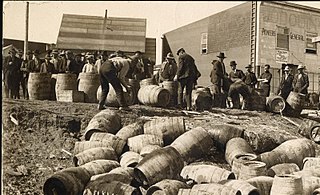
Rum-running, or bootlegging, is the illegal business of smuggling alcoholic beverages where such transportation is forbidden by law. Smuggling usually takes place to circumvent taxation or prohibition laws within a particular jurisdiction. The term rum-running is more commonly applied to smuggling over water; bootlegging is applied to smuggling over land.

USCGC Cape Henlopen was a 95-foot (29 m) type "C" Cape-class cutter constructed at the Coast Guard Yard at Curtis Bay, Maryland in 1958 for use as a law enforcement and search and rescue patrol boat.

The General Aviation PJ was a flying boat produced in the United States in the 1930s as a search-and-rescue aircraft for the Coast Guard. Five were built, with one converted to be a PJ-2 with engines in the other direction. The aircraft would land and take-off on water, but did have some wheels for when it was brought up on land from the water. They were in service until August 1941.
A rescue lifeboat is a boat rescue craft which is used to attend a vessel in distress, or its survivors, to rescue crew and passengers. It can be hand pulled, sail powered or powered by an engine. Lifeboats may be rigid, inflatable or rigid-inflatable combination-hulled vessels.

Traditionally, many different kinds of boats have been used as fishing boats to catch fish in the sea, or on a lake or river. Even today, many traditional fishing boats are still in use. According to the United Nations Food and Agriculture Organization (FAO), at the end of 2004, the world fishing fleet consisted of about 4 million vessels, of which 2.7 million were undecked (open) boats. While nearly all decked vessels were mechanised, only one-third of the undecked fishing boats were powered, usually with outboard engines. The remaining 1.8 million boats were traditional craft of various types, operated by sail and oars.

ABG fast interceptor craft are a series of thirteen 26-metre (85 ft) high-speed interceptor boats designed and supplied in knocked down kits by Henderson based Global Marine Design and assembled by ABG Shipyard, Surat for the Indian Coast Guard.
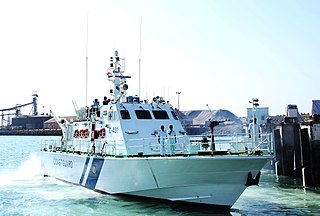
L&T fast interceptor craft are a series of high-speed interceptor boats being built by L&T Shipyard for the Indian Coast Guard. The ships are intended for patrol and rescue operations in India's Exclusive Economic Zone.
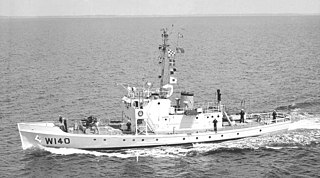
The Active-class patrol boat was one of the most useful and long-lasting classes of United States Coast Guard cutters. Of the 35 built in the 1920s, 16 were still in service during the 1960s. The last to be decommissioned from active service was the Morris in 1970; the last in actual service was the Cuyahoga, which sank after an accidental collision in 1978.
USCGC Point Roberts (WPB-82332) was an 82-foot (25 m) Point class cutter constructed at the Coast Guard Yard at Curtis Bay, Maryland in 1962 for use as a law enforcement and search and rescue patrol boat. Since the Coast Guard policy in 1961 was not to name cutters under 100 feet (30 m) in length, it was designated as WPB-82332 when commissioned and acquired the name Point Roberts in January 1964 when the Coast Guard started naming all cutters longer than 65 feet (20 m).
AMPL (P-2000) class of interceptor boats are series of ten watercraft built by M/s Anderson Marine Private Limited, Goa, India for the Indian Coast Guard.
Mandovani Marine (12.5-Meter) class of patrol crafts are a series of five watercraft built by Mandovi Marine Pvt LTD, Indore for Indian Coast Guard during the 1980s .
The Bristol class of interceptor craft are a series of watercraft built by Bristol Boats, a division of Chika Pvt. Ltd Aroor, for the Indian Coast Guard. These boats are intended for carrying out patrol duties in shallow water areas near the coastline. The contract was signed on 22 March 2004 for acquisition of eight Interceptor Boats by the Indian Coast Guard at a total cost of Rs 3.74 crores. The first craft became operational on 1 December 2004.
The Timblo class interceptor craft is a class of ten vessels built by Timblo Drydocks Pvt. Ltd, Goa for the Indian Coast Guard.
Mandovi Marine patrol crafts are 15 metre long patrol crafts with glass reinforced plastic hull built by Mandovi Marine Pvt LTD, Indore, India.

Bharati-class of interceptor boats are a series of fifteen watercraft being built by Bharati Shipyard for the Indian Coast Guard.
Timblo-class patrol crafts are a series of patrol workboat built by Timblo Drydocks Private Limited, Goa.

USCGC Morris (WSC-147), was a 125 ft (38 m) United States Coast Guard Active-class patrol boat in commission from 1927 to 1971. She was named for Robert Morris, (1734–1806) who was appointed in 1789 as United States Senator from Pennsylvania. In May 1966, she was redesignated as (WMEC-147).










